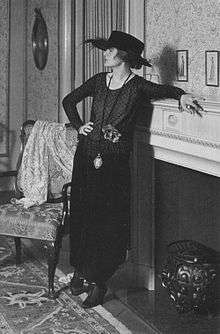Anita Berber
| Anita Berber | |
|---|---|
 Anita Berber in 1918 | |
| Born |
June 10, 1899 Leipzig, Germany |
| Died |
November 10, 1928 (aged 29) Kreuzberg, Germany |
| Occupation | Dancer, actress, writer |
Anita Berber (10 June 1899 – 10 November 1928) was a German dancer, actress, and writer who was the subject of an Otto Dix painting. She lived during the Weimar period.
Early life
Born in Leipzig to Felix Berber, First Violinist with the Municipal Orchestra, and Lucie Berber, an aspiring actress and singer, who later divorced, she was raised mainly by her grandmother in Dresden. By the age of 16, she had moved to Berlin and made her debut as a cabaret dancer. By 1918 she was working in film, and she began dancing nude in 1919. Scandalously androgynous, she quickly made a name for herself. She wore heavy dancer's make-up, which on the black-and-white photos and films of the time came across as jet black lipstick painted across the heart-shaped part of her skinny lips, and charcoaled eyes.[1]
Notoriety in Berlin
Her hair was cut fashionably into a short bob and was frequently bright red, as in 1925 when the German painter Otto Dix painted a portrait of her, titled "The Dancer Anita Berber". Her dancer friend and sometime lover Sebastian Droste, who performed in the film Algol (1920), was skinny and had black hair with gelled up curls much like sideburns. Neither of them wore much more than lowslung loincloths and Anita occasionally a corsage worn well below her small breasts.[1]
Her performances broke boundaries with their androgyny and total nudity, but it was her public appearances that really challenged taboos. Berber's overt drug addiction and bisexuality were matters of public chatter.[2] In addition to her addiction to cocaine, opium and morphine, one of Berber's favourites was chloroform and ether mixed in a bowl.[3] This would be stirred with a white rose, the petals of which she would then eat.[4]
Aside from her addiction to narcotic drugs, she was also a heavy alcoholic. In 1928, at the age of 29, she suddenly gave up alcohol completely, but died later the same year. She was said to be surrounded by empty morphine syringes.[4] According to Mel Gordon, in The Seven Addictions and Five Professions of Anita Berber: Weimar Berlin's Priestess of Debauchery,[5] she was diagnosed with severe tuberculosis while performing abroad. After collapsing in Damascus, she returned to Germany and died in a Kreuzberg hospital on 10 November 1928. She was buried in a pauper's grave in St. Thomas Cemetery in Neukölln.[6]
Marriages
In 1919, she entered into a marriage of convenience with a man with the surname Nathusius. She later left him in order to pursue a relationship with a woman named Susi Wanowski, and became part of the Berlin lesbian scene.[7]
Her second marriage—in 1922—was to Sebastian Droste. This lasted until 1923. In 1925, she married a gay American dancer named Henri Chatin-Hofmann.[7]
Legacy
A 1987 film by Rosa von Praunheim titled Anita - Tänze des Lasters focuses on the life of Anita Berber.[8]

The band Death in Vegas named a song after her, which is on the album Satan's Circus. It is frequently used on the NPR radio show This American Life.
Selected filmography
- The Story of Dida Ibsen (1918)
- Around the World in Eighty Days (1919)
- Figures of the Night (1920)
- The Count of Cagliostro (1920)
- Lucrezia Borgia (1922)
- Vienna, City of Song (1923)
- A Waltz by Strauss (1925)
References
- 1 2 "Glitter & Doom - Anita, mon amour". Wound Magazine. London. 1 (1): 150–151. November 2007. ISSN 1755-800X.
- ↑ Pettis, Ruth M. (16 August 2005). "Berber, Anita". glbtq.com. Archived from the original on 30 December 2008. Retrieved 2008-11-18.
- ↑ Mel Gordon (1 May 2006). Voluptuous panic: the erotic world of Weimar Berlin. Feral House. pp. 9–. ISBN 978-1-932595-11-6. Retrieved 14 November 2011.
- 1 2 Berlin: Metropolis of Vice. Paradigm Pictures, 2005.
- ↑ Mel Gordon (2006). The Seven Addictions and Five Professions of Anita Berber: Weimar Berlin's Priestess of Debauchery. Los Angeles, California: Feral House. ISBN 1-932595-12-0.
- ↑ "Anarchists of Style: Anita Berber, Part 2" http://www.wornthrough.com/2011/01/11/anarchists-of-style-anita-berber-part-2/.
- 1 2 Andrea Capovilla. Who's Who in Gay and Lesbian History. Routledge. p. 60. ISBN 0415159830.
- ↑ "Anita - Tänze des Lasters". The Internet Movie Database. Retrieved 2007-11-13.
Lania, Leo. Der Tanz ins Dunkel: Anita Berber
" Berlin 1929.
Bibliography
- Gordon, Mel (2006) The Seven Addictions and Five Professions of Anita Berber: Weimar Berlin's Priestess of Debauchery. Los Angeles, California: Feral House
- Capovilla, Andrea (2001) "Berber, Anita" in: Aldrich, Robert & Wotherspoon, Garry (eds.) Who's Who in Contemporary Gay and Lesbian History: From Antiquity to World War II. New York: Routledge; pp. 50–51
- Fischer, Lothar (1996) Tanz zwischen Rausch und Tod: Anita Berber, 1918-1928 in Berlin. Berlin: Haude und Spener
- Funkenstein, Susan Laikin (2005) "Anita Berber: Imaging a Weimar Performance Artist" in: Woman's Art Journal 26.1 (Spring/Summer 2005); pp. 26–31
- Gill, Anton (1993) A Dance between the Flames: Berlin between the Wars. New York: Carroll & Graf
- Jarrett, Lucinda (1997) Stripping in Time: a history of erotic dancing. London: Pandora (HarperCollins); pp. 112–135
- Kolb, Alexandra (2009) Performing Femininity. Dance and Literature in German Modernism. Oxford: Peter Lang. ISBN 978-3-03911-351-4
- Richie, Alexandra (1998) Faust's Metropolis: A History of Berlin. New York: Carroll and Graf
- Toepfer, Karl Eric (1997) Empire of Ecstasy: Nudity and Movement in German Body Culture, 1910-1935. Berkeley: University of California Press
- Berber, Anita (& Droste, Sebastian), Dances of Vice, Horror, and Ecstasy (A full translation from the German by Merrill Cole) (Newcastle upon Tyne: Side Real Press 2012)
External links
- Anita Berber at the Internet Movie Database
- Legendary Sin Cities (CBC series -- "Berlin: Metropolis of Vice")
- Photographs of Anita Berber